Key takeaways:
- Selective mutism is a complex anxiety disorder that can lead to frustration and isolation, emphasizing the need for empathy and understanding in social interactions.
- Preparation and setting small social goals can significantly boost confidence in engaging with new people and navigating social situations.
- Building confidence is a gradual process marked by small victories, such as sharing personal stories or engaging in conversations, which fosters connections and reduces anxiety.
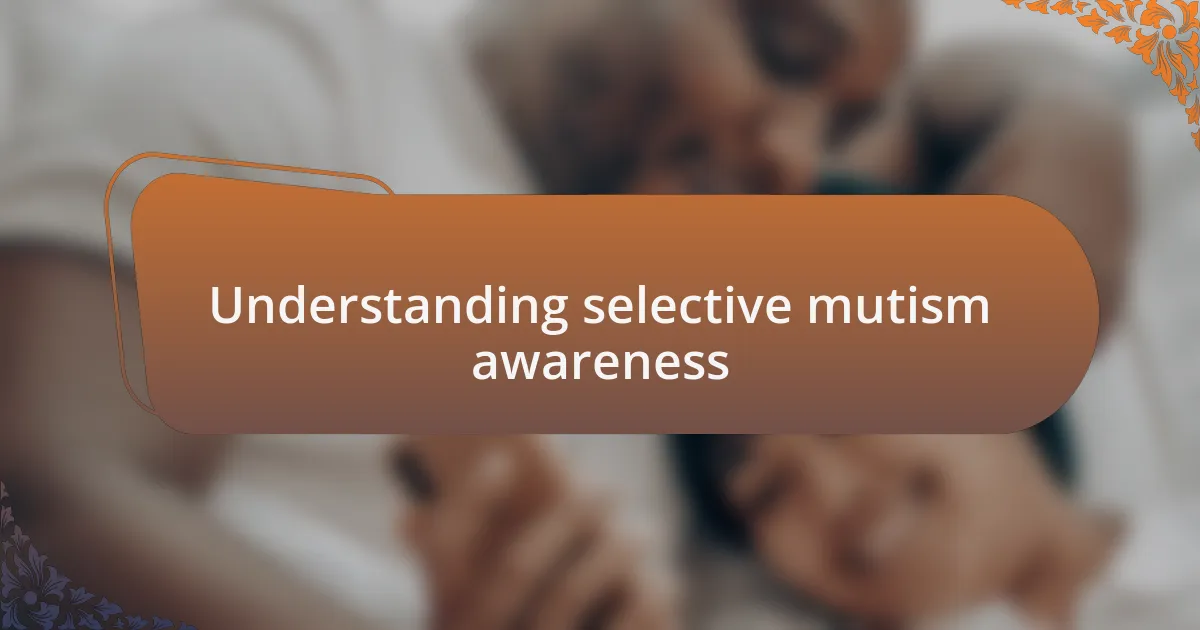
Understanding selective mutism awareness
Selective mutism is often misunderstood, leading to frustration and isolation for those affected. I remember feeling a wave of anxiety wash over me in new social gatherings, where speaking felt like an impossible task. Isn’t it heartbreaking when you have thoughts bubbling inside, yet silence forms a barrier?
Awareness surrounding selective mutism is crucial. For instance, rather than assuming someone is shy or rude, understanding that they might be grappling with a complex condition can foster empathy. Have you ever considered how small acts of kindness—like a gentle smile or a supportive nod—can make a world of difference for someone struggling to communicate?
It’s essential to highlight that selective mutism isn’t a choice; it’s an anxiety disorder deeply rooted in the fear of social interactions. I recall a moment at a family gathering where my heart raced as everyone chatted. In that instant, I realized that awareness not only helps others understand but also empowers individuals like me to navigate our unique challenges with a bit more confidence.
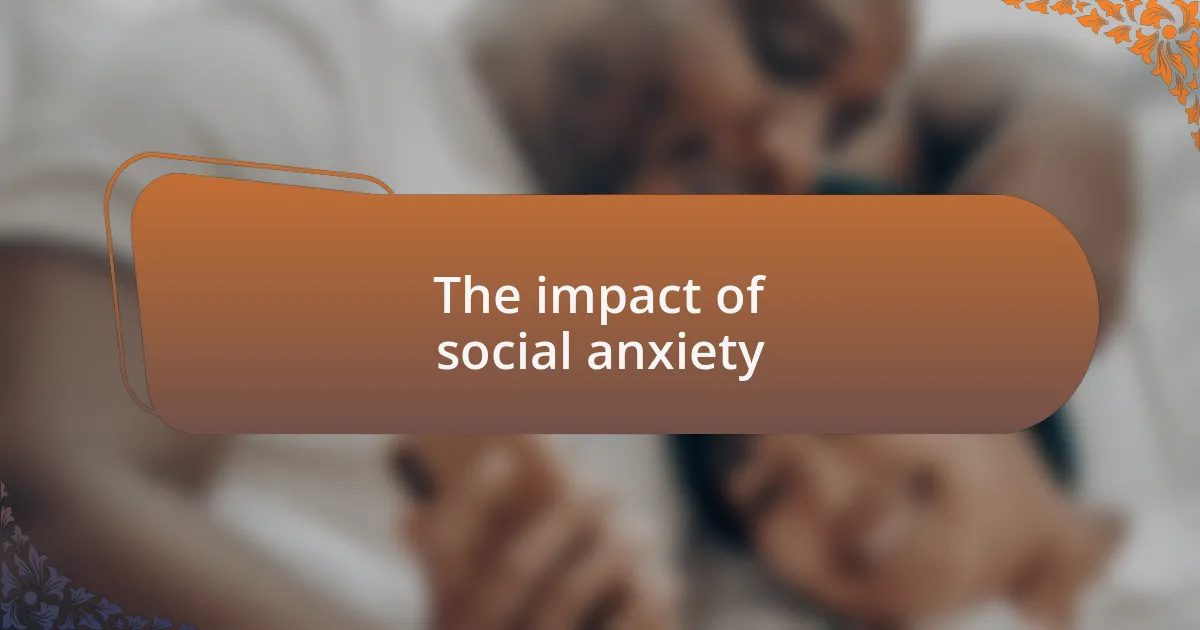
The impact of social anxiety
Social anxiety can cast a long shadow over our experiences in new social settings. I vividly remember walking into a room full of unfamiliar faces, my palms sweating and heart racing. Have you ever felt that knot in your stomach, a silent plea to just blend into the background rather than engage? It’s a powerful reminder of how deeply anxiety can affect one’s ability to connect with others.
The feelings tied to social anxiety are often overwhelming. I found that even the simplest interactions, like making eye contact or initiating small talk, became monumental challenges. Is it just me, or do those moments feel like standing on a tightrope, with the fear of falling at any moment? It’s important for others to recognize that this struggle isn’t about unwillingness to participate, but rather an emotional weight that can be incredibly heavy to bear.
In social situations, the impact of anxiety becomes particularly evident in body language and communication. I noticed that I often resorted to nodding or smiling to convey understanding, afraid to voice my thoughts. Isn’t it fascinating how our minds can feel so stifled while our bodies still wish to engage? Understanding this can deepen our empathy and offer support to those who feel trapped in silence.

Recognizing new social settings
Recognizing new social settings can be a daunting task, especially when you’re not sure what to expect. I remember entering a gathering at a friend’s house, feeling like a fish out of water. Have you ever tried to navigate a sea of unknowns, scanning the room for familiar faces or cues that create a sense of belonging? This uncertainty can be both triggering and enlightening.
Every new environment carries its own set of unspoken rules and dynamics. Once, at a community event, I stood awkwardly near the refreshments, observing interactions from a distance. The subtle exchanges among others often felt like reading a book in a different language. How do we decode these social signals? Thankfully, being aware of these nuances helped me gradually engage more comfortably over time.
It’s fascinating how our surroundings influence our comfort levels. In quieter settings, I found myself more inclined to observe rather than participate, while in lively atmospheres, I sometimes felt compelled to jump into the fray. Can you relate to the shifting balance of energy in these spaces? Acknowledging our feelings about different environments can empower us to adapt and hopefully, connect more authentically.
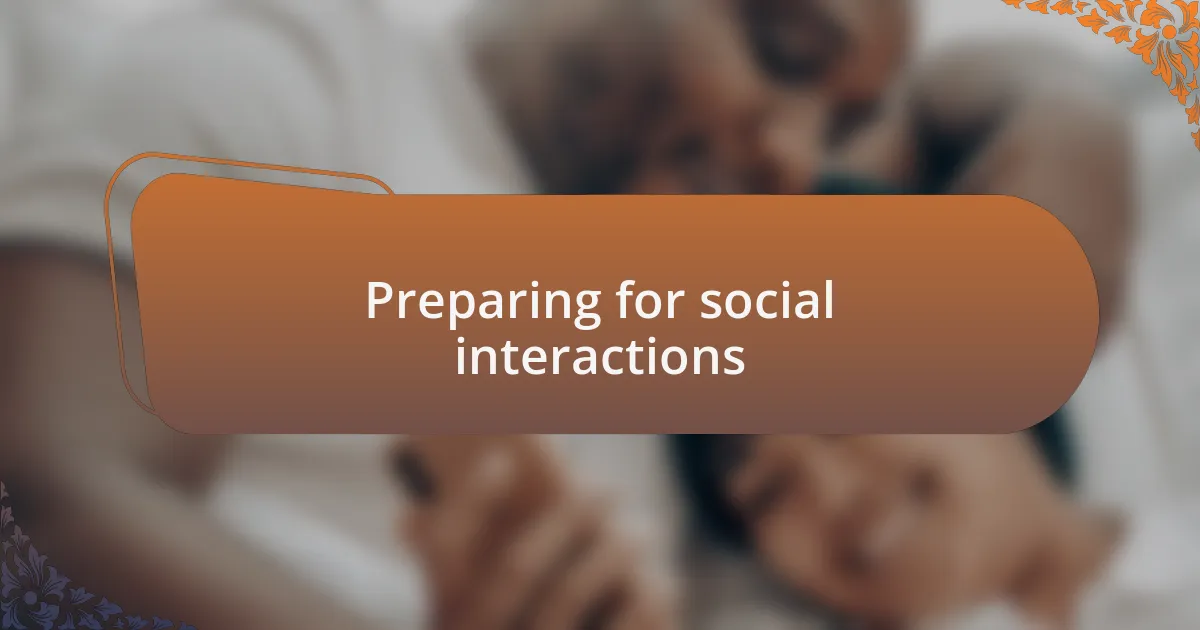
Preparing for social interactions
Preparing for social interactions often begins with a mental checklist. I find that taking a moment to visualize the event can help ease my nerves. Have you ever imagined yourself walking into a room, feeling confident and prepared? This simple mental practice can set a positive tone for the entire interaction.
It’s also helpful to identify possible conversation starters beforehand. One time, I went to a book club meeting where I prepared a few questions about the latest read. When the discussion began, my preparation provided me with a safety net, allowing me to contribute without feeling lost. What topics do you think might interest others? Anticipating these can make the conversation flow more naturally.
Lastly, embracing small social goals can significantly enhance the interaction experience. At a recent family gathering, I aimed to speak to at least three new people. Though it felt challenging, each successful connection boosted my confidence. What if you set a similar goal for yourself? You might be surprised at how it transforms your approach to social settings.
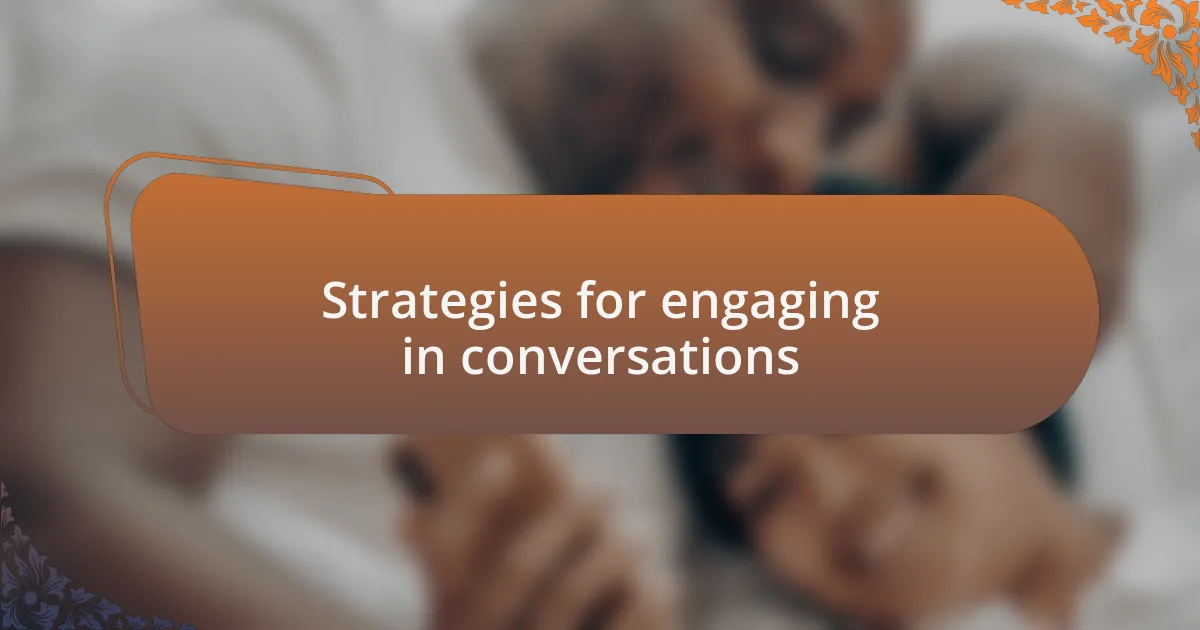
Strategies for engaging in conversations
Engaging in conversations can be daunting, but I’ve discovered that asking open-ended questions can work wonders. For instance, at a recent networking event, I inquired about others’ favorite hobbies. This not only sparked lively discussions but also took the pressure off me, allowing them to talk more while I listened. Have you tried steering conversations in this way?
Another effective strategy I’ve found is to focus on genuine listening. I remember standing in a small circle at a friend’s gathering, feeling anxious about my contribution. By concentrating on what others were saying and nodding along, I felt more present. This approach transformed my anxiety into curiosity. How often do you catch yourself daydreaming instead of engaging?
Finally, sharing relatable personal stories can serve as a great bridge to deeper conversations. I once shared a funny experience from a recent travel mishap, and it not only evoked laughter but encouraged others to share their own travel stories. It’s incredible how a simple anecdote can create a sense of connection. Have you thought about how your unique experiences could spark interaction?
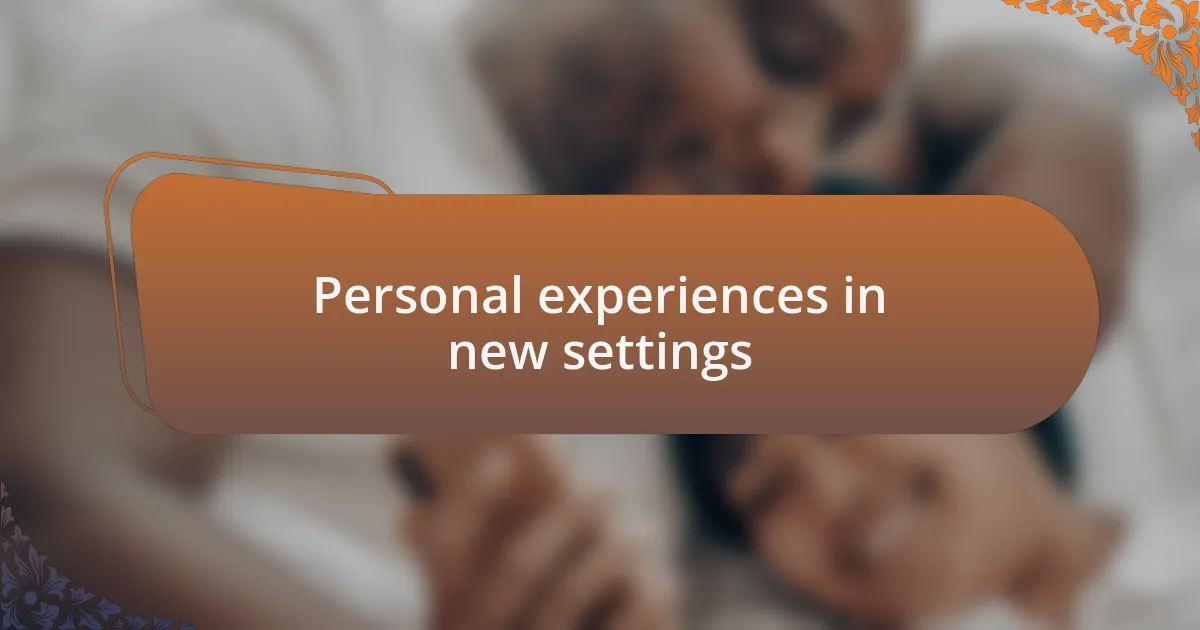
Personal experiences in new settings
In navigating new social settings, I often find myself feeling a mix of excitement and anxiety. At a recent birthday party, I stood by the snack table, taking a moment to observe before diving into conversation. It reminded me of how crucial it can be to find a familiar anchor, even in a sea of new faces. Have you ever felt that blend of anticipation and apprehension?
I recall an instance during a community volunteering event where I hesitated before introducing myself to a larger group. My heart raced, but I took a deep breath and simply stated my name and why I was there. To my surprise, it encouraged others to share similar sentiments, diffusing my initial tension. Isn’t it amazing how vulnerability can pave the way for connection?
Reflecting on my experiences, I’ve realized that the stories we carry influence our interactions in new environments. Once, while attending a workshop, I opened up about my struggle with selective mutism and how it shapes my social encounters. Instead of shying away, I found people genuinely interested and supportive. How often do we overlook the power of shared narratives in fostering understanding?
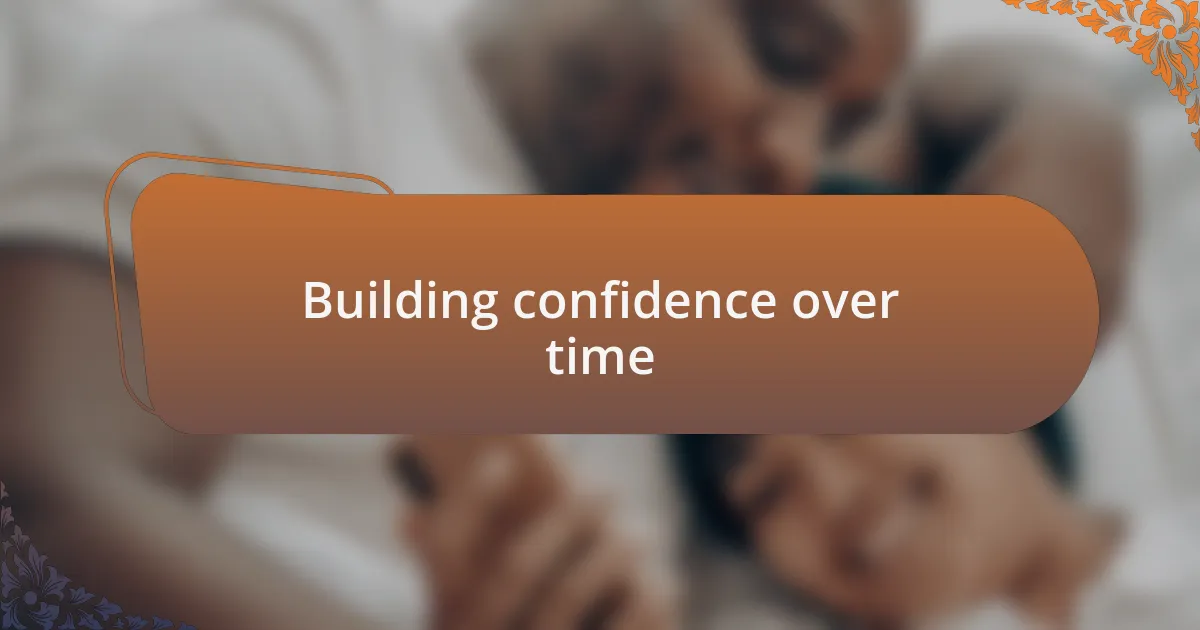
Building confidence over time
Building confidence over time is a journey filled with small victories. I remember attending a book club for the first time, where I felt completely out of my element. After a few meetings of listening and nodding along, I finally mustered the courage to share my thoughts on a book. The supportive nods and words of encouragement from the group made me realize that every little step was building my confidence, piece by piece.
One evening, I found myself at a networking event, grappling with the urge to retreat whenever I felt overwhelmed. Instead of giving in, I decided to set a personal goal: to engage with three new people. By focusing on just those interactions, I found that after each chat, my nervousness diminished slightly. Have you ever noticed how accomplishing small goals in unfamiliar settings can create a sense of accomplishment and propel you forward?
As I’ve continued to challenge myself in social situations, I’ve learned that confidence is not an inherent trait, but a muscle we develop over time. There was a particularly challenging moment when I spoke at a local coffee shop, sharing my experiences with selective mutism. I felt vulnerable but also empowered, as the supportive responses from the audience were a profound reminder that growth often lies right outside our comfort zones. How often do we fail to recognize these moments as milestones in our journey towards greater self-assurance?